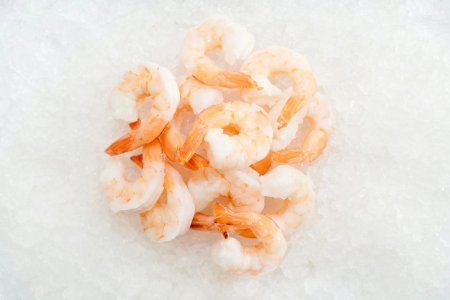Prices on these 11 groceries are rising—see if you’re overpaying because of new tariffs!
By
Veronica E.
- Replies 0
Have you noticed higher prices at your local grocery store lately? You're not alone.
The newly implemented "Liberation Day" tariffs are making waves in grocery aisles across the country, affecting everything from your morning coffee to your favorite snacks.
With import duties as high as 49%, these tariffs could be impacting your weekly shopping in ways you might not expect.
At The GrayVine, we understand how important it is to make every dollar count, especially when it feels like prices are always on the rise.
Let’s explore how these new tariffs are impacting your grocery bill and what you can do to stay ahead.

What Are These New Tariffs?
The "Liberation Day" tariffs, introduced by President Trump, target key trading partners, with duties as high as 49% on many imports.
Larger stores might absorb some of the costs, but smaller shops could pass the price increases directly to consumers.
Here’s a look at the 11 grocery items that are seeing price hikes due to these new tariffs:
1. Rice and Instant Noodles from Vietnam
The 46% tariff on imports from Vietnam may raise prices on a variety of goods, including Nike sneakers, jasmine rice, and well-known noodle brands like Hảo Hảo, making them more expensive.
Additionally, items like coffee, pepper, and electronics—key exports from Vietnam—could also experience price hikes.
2. Soy Sauce and Ramen from Japan
Japan is facing a 24% tariff, which could affect popular pantry staples like ramen noodles and soy sauce.
In addition, Japan is a major exporter of motor vehicles, which are now subject to a 25% tariff, along with items like Wagyu beef and curry roux.
3. Olive Oil and Cheese from the European Union
European countries are now subject to a 20% tariff, which could affect items ranging from champagne to cheese and olive oil, particularly for specialty importers.
European Commission President Ursula von der Leyen told EU lawmakers, "Europe has not started this confrontation.
We do not necessarily want to retaliate, but if necessary, we have a strong plan to do so and we will use it."
Also read: Trade tensions rise between US and Canada—tariff decisions pending
4. Tea and Spices from India
India is facing a 28% reciprocal tariff, which could significantly increase the prices of grocery items like tea, spices, and curry powders.
Additionally, India's exports of processed foods, cocoa, and sugar may be impacted, as well as US clothing processing factories that import cotton garments.
5. Snacks and Drinks from South Korea
South Korea is now facing a 25% tariff, which could lead to price hikes on products like instant coffee, seaweed snacks,
Binggrae banana-flavored milk, and electronics.
Retailers who depend on Korean imports may have to raise prices to offset the additional costs, so if you have go-to snacks, it might be wise to stock up while you can.

Also read: Slash your grocery bill now: 5 smart swaps to outsmart rising tariff costs!
6. Canned Tuna and Coconut Milk from Thailand
Thailand is a major exporter of coconut milk, coconut cream (both regular and organic), fish sauce (like the Red Boat brand), curry pastes, canned tuna, frozen shrimp, rice, and more.
With a 36% tariff now in place, these imports could see significant price increases.
According to AP, South Korea had a $66 billion trade surplus with the US last year, which could also be affected by these changes.
7. Cocoa and Instant Coffee from Switzerland
A 31% tariff on Swiss imports could drive up prices on luxury chocolates like Toblerone, Lindt, and Torino, as well as instant coffee mixes such as Nescafé, Café Royal, and Chicco d'Oro.
Switzerland, known for exporting vaccines, watches, and precious metals, could also see these products affected by the new tariffs.
Also read: New trade tariffs could spike grocery prices—here’s how to stay ahead
8. Peanut Oil and Long-Grain Rice from China
China is facing a significant 34% tariff, which could affect products like toys, fast fashion, cell phones, and other electronics.
Grocery items such as rice, cooking oils, and soy products may also see price increases.
Additionally, with China's large frozen shellfish export business, expect higher prices on frozen shrimp in the near future.
9. Canned Fruit and Seafood from Taiwan
Taiwan is a key exporter of snacks to the US, which could be impacted by the 32% tariff.
The country also supplies a significant amount of non-alcoholic beverages, canned fruit, seafood, and bakery items.
With Taiwan producing 90% of the most advanced electronic chips, prices for cell phones and other devices may rise as well.

Also read: These US cities could be hit hardest by the trade war with Canada—is your city one of them?
10. Condensed Milk and Coffee Mixes from Malaysia
Malaysia’s 29% tariff could affect products like F & N sweetened condensed milk and 3-in-1 coffee blends, such as Aik Cheong Instant Mix Coffee.
Smaller importers may feel the pinch more than larger ones and could raise their prices accordingly.
Malaysia also exports a significant amount of fruit, including Durian, cocoa, and processed foods to the US.
11. Whisky, Tea, and Sugar from the UK
The US is the UK's largest export market for goods and services, including food items, totaling £2.0 billion in 2021, according to the UK government.
The 10% tariff on the UK could affect items like whisky, chocolate, cheese, tea, beer, snacks, salmon, sugar, gin, and more.
For Scotch whisky makers, the US is especially vital, with the market worth £971 million a year, according to the BBC.

What Can You Do About Rising Costs?
As prices climb, it's important to be strategic. Here are a few tips for managing your grocery budget during these changes:
Though the immediate effect is on our wallets, there’s a larger economic story at play.
Tariffs are commonly used to support domestic industries, but they can also result in trade disputes, which may have lasting impacts on the global economy and personal finances.
Read next: Boost your nest egg: 4 must-start side hustles before 2025

At The GrayVine, we want to stay informed and proactive in these changing times. Have you noticed any price changes in your grocery store? How are you adjusting your shopping habits? Let’s share our experiences and help each other navigate through these price hikes.
The newly implemented "Liberation Day" tariffs are making waves in grocery aisles across the country, affecting everything from your morning coffee to your favorite snacks.
With import duties as high as 49%, these tariffs could be impacting your weekly shopping in ways you might not expect.
At The GrayVine, we understand how important it is to make every dollar count, especially when it feels like prices are always on the rise.
Let’s explore how these new tariffs are impacting your grocery bill and what you can do to stay ahead.

Rising prices on everyday grocery items due to new tariffs—what it means for your shopping list. Image Source: Pexels / Natalia S.
What Are These New Tariffs?
The "Liberation Day" tariffs, introduced by President Trump, target key trading partners, with duties as high as 49% on many imports.
Larger stores might absorb some of the costs, but smaller shops could pass the price increases directly to consumers.
Here’s a look at the 11 grocery items that are seeing price hikes due to these new tariffs:
1. Rice and Instant Noodles from Vietnam
The 46% tariff on imports from Vietnam may raise prices on a variety of goods, including Nike sneakers, jasmine rice, and well-known noodle brands like Hảo Hảo, making them more expensive.
Additionally, items like coffee, pepper, and electronics—key exports from Vietnam—could also experience price hikes.
2. Soy Sauce and Ramen from Japan
Japan is facing a 24% tariff, which could affect popular pantry staples like ramen noodles and soy sauce.
In addition, Japan is a major exporter of motor vehicles, which are now subject to a 25% tariff, along with items like Wagyu beef and curry roux.
3. Olive Oil and Cheese from the European Union
European countries are now subject to a 20% tariff, which could affect items ranging from champagne to cheese and olive oil, particularly for specialty importers.
European Commission President Ursula von der Leyen told EU lawmakers, "Europe has not started this confrontation.
We do not necessarily want to retaliate, but if necessary, we have a strong plan to do so and we will use it."
Also read: Trade tensions rise between US and Canada—tariff decisions pending
4. Tea and Spices from India
India is facing a 28% reciprocal tariff, which could significantly increase the prices of grocery items like tea, spices, and curry powders.
Additionally, India's exports of processed foods, cocoa, and sugar may be impacted, as well as US clothing processing factories that import cotton garments.
5. Snacks and Drinks from South Korea
South Korea is now facing a 25% tariff, which could lead to price hikes on products like instant coffee, seaweed snacks,
Binggrae banana-flavored milk, and electronics.
Retailers who depend on Korean imports may have to raise prices to offset the additional costs, so if you have go-to snacks, it might be wise to stock up while you can.

Spices from India could become more expensive with the new 28% tariff, affecting your pantry favorites. Image Source: Pexels / Mareefe.
Also read: Slash your grocery bill now: 5 smart swaps to outsmart rising tariff costs!
6. Canned Tuna and Coconut Milk from Thailand
Thailand is a major exporter of coconut milk, coconut cream (both regular and organic), fish sauce (like the Red Boat brand), curry pastes, canned tuna, frozen shrimp, rice, and more.
With a 36% tariff now in place, these imports could see significant price increases.
According to AP, South Korea had a $66 billion trade surplus with the US last year, which could also be affected by these changes.
7. Cocoa and Instant Coffee from Switzerland
A 31% tariff on Swiss imports could drive up prices on luxury chocolates like Toblerone, Lindt, and Torino, as well as instant coffee mixes such as Nescafé, Café Royal, and Chicco d'Oro.
Switzerland, known for exporting vaccines, watches, and precious metals, could also see these products affected by the new tariffs.
Also read: New trade tariffs could spike grocery prices—here’s how to stay ahead
8. Peanut Oil and Long-Grain Rice from China
China is facing a significant 34% tariff, which could affect products like toys, fast fashion, cell phones, and other electronics.
Grocery items such as rice, cooking oils, and soy products may also see price increases.
Additionally, with China's large frozen shellfish export business, expect higher prices on frozen shrimp in the near future.
9. Canned Fruit and Seafood from Taiwan
Taiwan is a key exporter of snacks to the US, which could be impacted by the 32% tariff.
The country also supplies a significant amount of non-alcoholic beverages, canned fruit, seafood, and bakery items.
With Taiwan producing 90% of the most advanced electronic chips, prices for cell phones and other devices may rise as well.

Do you love frozen shrimp? The new 36% tariff on Thai imports might make your favorite seafood a bit pricier. Image Source: Pexels / Deane Bayas.
Also read: These US cities could be hit hardest by the trade war with Canada—is your city one of them?
10. Condensed Milk and Coffee Mixes from Malaysia
Malaysia’s 29% tariff could affect products like F & N sweetened condensed milk and 3-in-1 coffee blends, such as Aik Cheong Instant Mix Coffee.
Smaller importers may feel the pinch more than larger ones and could raise their prices accordingly.
Malaysia also exports a significant amount of fruit, including Durian, cocoa, and processed foods to the US.
11. Whisky, Tea, and Sugar from the UK
The US is the UK's largest export market for goods and services, including food items, totaling £2.0 billion in 2021, according to the UK government.
The 10% tariff on the UK could affect items like whisky, chocolate, cheese, tea, beer, snacks, salmon, sugar, gin, and more.
For Scotch whisky makers, the US is especially vital, with the market worth £971 million a year, according to the BBC.

The 10% tariff on UK imports could soon make your favorite cheese varieties a bit pricier. Image Source: Pexels / Tabitha Mort.
What Can You Do About Rising Costs?
As prices climb, it's important to be strategic. Here are a few tips for managing your grocery budget during these changes:
- Compare prices: Shop around, visit different stores, or explore bulk retailers for better deals.
- Substitute affected items: Choose similar products from countries not facing high tariffs.
- Buy in bulk: Stock up on non-perishable goods when possible.
- Use sales and coupons: Take advantage of discounts to balance out the price increases.
- Support local: Local produce and goods might offer a more affordable option while supporting domestic businesses.
Though the immediate effect is on our wallets, there’s a larger economic story at play.
Tariffs are commonly used to support domestic industries, but they can also result in trade disputes, which may have lasting impacts on the global economy and personal finances.
Read next: Boost your nest egg: 4 must-start side hustles before 2025
Key Takeaways
- President Trump's "Liberation Day" tariffs are resulting in increased import duties, which could lead to higher prices for certain grocery items in the US.
- Tariffs are affecting a range of products from countries like Vietnam, Japan, the European Union, India, South Korea, Thailand, Switzerland, China, Taiwan, Malaysia, and the UK.
- Essential grocery items such as rice, soy sauce, olive oil, spices, canned tuna, and coconut milk may see price hikes as a consequence of these tariffs.
- The impact on prices may vary depending on the reliance of retailers on imports, with smaller specialty importers potentially needing to raise prices more significantly than larger retailers.
At The GrayVine, we want to stay informed and proactive in these changing times. Have you noticed any price changes in your grocery store? How are you adjusting your shopping habits? Let’s share our experiences and help each other navigate through these price hikes.






